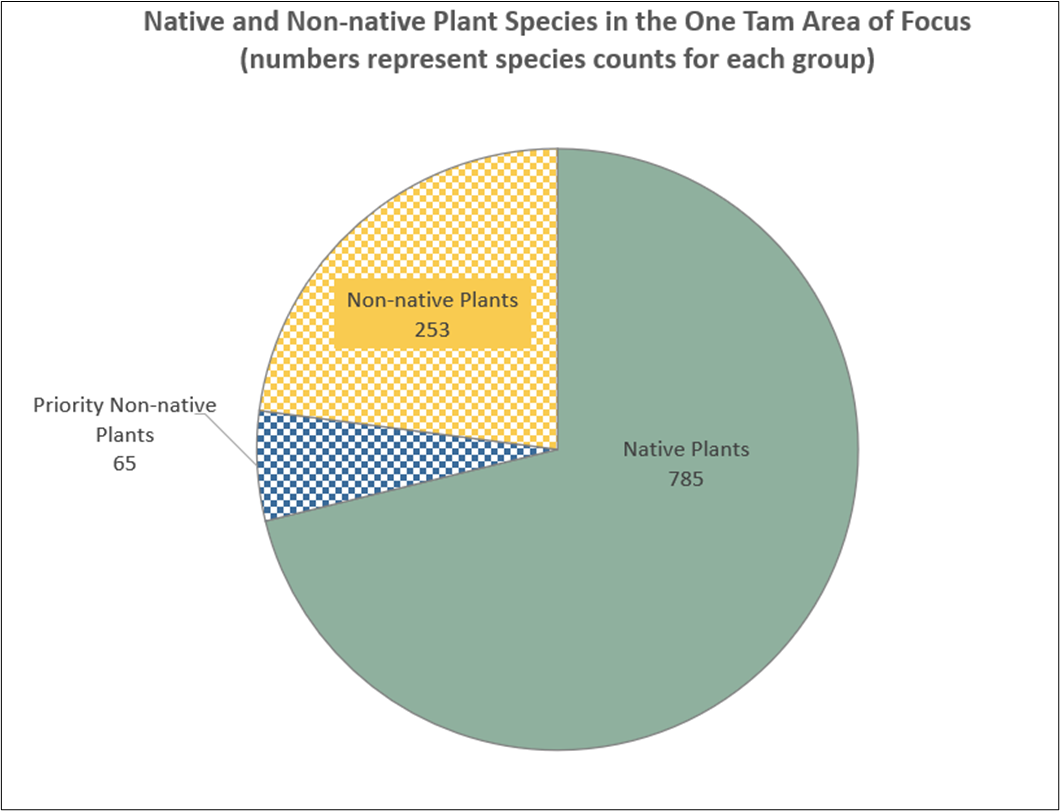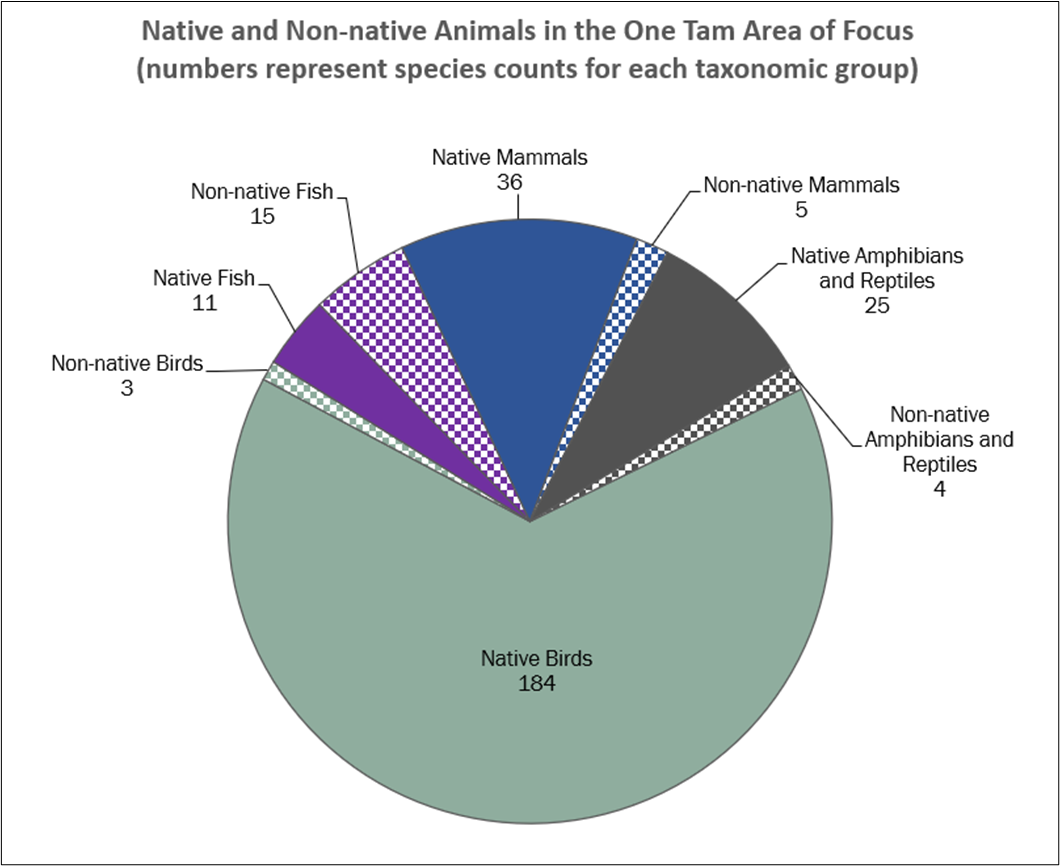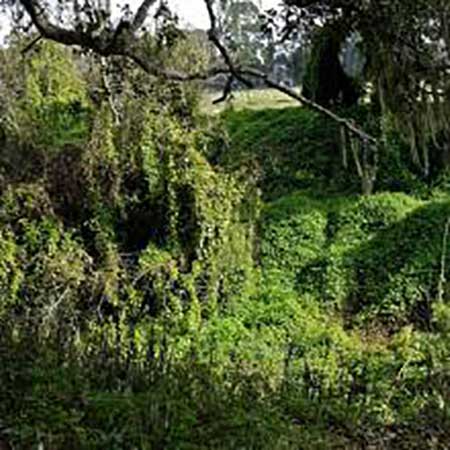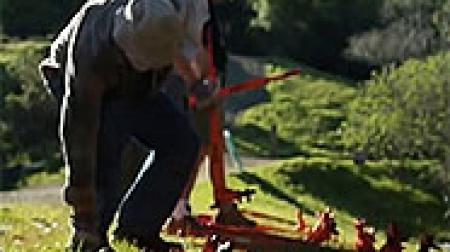Non-native, Invasive Species on Mt. Tam
A plant or animal that has been introduced—either intentionally or not—to a new region is considered non-native, but not necessarily invasive. Invasive species display particular characteristics—e.g., fast growth, abundant offspring, and rapid maturation—that, when combined with a lack of natural predators and diseases that help control them in their native environment, allow them to rapidly grow and spread, frequently displacing native species.
Non-native, invasive species in Marin County come in myriad forms, including water molds, plants,invertebrates, fish, amphibians, birds, and mammals. The major threats posed by invasive species include changes in fire frequency or intensity, groundwater depletion, changes to soil chemistry, competition with native species, and a loss of native species diversity (LCA, 2009).
Plants
While all natural areas on Mt. Tam face some degree of threat from invasive plant species, soil type, moisture level, and shade make some areas more resistant than others to invasion. Furthermore, small, patchy habitats have more gaps for invasive species to take hold, as well as more edges that may be exposed to invasion. Larger, more intact habitat patches and more remote parts of the mountain, on the other hand, may have fewer pathways—i.e., roads, trails, or human development corridors—for invasive-species dispersion.
The higher winter temperatures, longer and warmer growing seasons, and more frequent drought or storms predicted under future climate change scenarios may affect native ecosystems adapted to existing conditions by reducing resiliency and increasing the risk of spreading invasive plants (Frey et al., 2015).
Currently, about 30% of the known plant species on Mt. Tam are non-native. Of those, around 65 are priority species targeted for early detection, mapping, and control by the One Tam Conservation Management Program.
Although the highest-priority species are not currently widespread in Marin County or on Mt. Tam, they have demonstrated a capacity to harm to ecosystems in other regions or adjacent counties. Because suitable habitat for these species is found on Mt. Tam, it is critical that we find and manage incipient populations in their early stages. In 2020, the One Tam Conservation Management Program reviewed 10 years of invasive-plant data to prioritize control projects across the mountain. As of 2023, approximately 90% of the patches of the highest-priority species are being treated annually. One Tam partners continue to review local detections of widespread invasive plants for mountain-wide containment and control.
Other non-native, invasive species that are widespread in the county and/or on Mt. Tam are closely controlled by the mountain’s land management agencies via existing vegetation programs using staff and volunteer support. These species may become high priorities for removal when found in small amounts far from source populations.

Animals
Non-native, invasive animals compete with native species for food, shelter, and nest or den sites. Some of them also prey directly on native species. There are more than 20 known non-native animal species on Mt. Tam (Figure 1.5). Species of particular concern include:
- The American bullfrog (Lithobates catesbeianus) competes with and preys upon other amphibian species, including the federally threatened California red-legged frog (Rana draytonii) as well as the foothill yellow-legged frog (R. boylii), a federal and state species of concern
- The signal crayfish (Pacifastacus leniusculus) preys upon the juvenile foothill yellow-legged frog
- The red-eared slider (Trachemys scripta elegans) and other non-native turtles compete with and prey upon native aquatic wildlife
- The wild turkey (Meleagris gallopavo) eats seeds, invertebrates, small vertebrates, and other food needed by native species, and its foraging damages native vegetation and causes soil disturbance and erosion
- Domestic and feral cats (Felis catus) prey on native birds, rodents, and reptiles

resources
Animal and Plant Health Inspection Service [APHIS]. (2022). List of regulated hosts and plants proven or associated with Phytophthora ramorum. U.S. Department of Agriculture. https://tinyurl.com/bde9v2js
Cunniffe, N. J., Cobb, R. C., Meentemeyer, R. K., Rizzo, D. M., & Gilligan, C. A. (2016). Modeling when, where, and how to manage a forest epidemic, motivated by sudden oak death in California. Proceedings of the National Academy of Sciences USA (20), 5640–5645. https://doi.org/10.1073/pnas.1602153113
Frey, M., Perlmutter, M., Williams, A., & Gluesenkamp, D. (2015). The San Francisco Bay Area early detection network. Management of Biological Invasions, 6(3), 231–241. http://dx.doi.org/10.3391/mbi.2015.6.3.02
Garbelotto, M., & Rizzo, D. (2005). A California-based chronological review (1995–2004) of research on Phytophthora ramorum, the causal agent of sudden oak death. Phytopathologia Mediterranea, 44(2), 127–143.https://www.jstor.org/stable/26463196
Golden Gate National Parks Conservancy [GGNPCa]. (2023). Marin regional forest health strategy.Tamalpais Lands Collaborative (One Tam).https://www.onetam.org/forest-health
Leonard Charles Associates [LCA]. (2009). Biodiversity management plan for Marin Municipal Water District lands. Prepared for Marin Municipal Water District.
Nelson, P. A. and Golden Gate National Parks Conservancy [GGNPC] (2023). Chapter 3: Tribal Stewardship & Partnership. In Marin Regional Forest Health Strategy (pp. 63-90). Tamalpais Lands Collaborative (One Tam). https://www.onetam.org/forest-health
Sims, L., Conforti, C., Gordon, T., Larssen, N., & Steinharter, M. (2016). Presidio phytophthora management recommendations [Unpublished report]. https://tinyurl.com/4uvrtfbh



